#jungle king tar-chan
Explore tagged Tumblr posts
Text
A funny design of Tar-chan and Jane from the retro manga/anime Jungle King Tar-chan.
#Jungle King Tar-chan#Jungle King Tar Chan#Janguru no Oja Ta-chan#Tar-chan#Jane#80s anime#70s anime#vintage anime#childhood nostalgia#Nostalgic anime#anime of the old times#retro anime#80s manga#70s manga#vintage manga#Nostalgic manga#manga of the old times#retro manga#ジャングルの王者ターちゃん
0 notes
Text
Jungle King Tar-chan (Sun L - Game Boy - 1994)

ジャングルの王者ターちゃん (1994年7月29日)
74 notes
·
View notes
Text
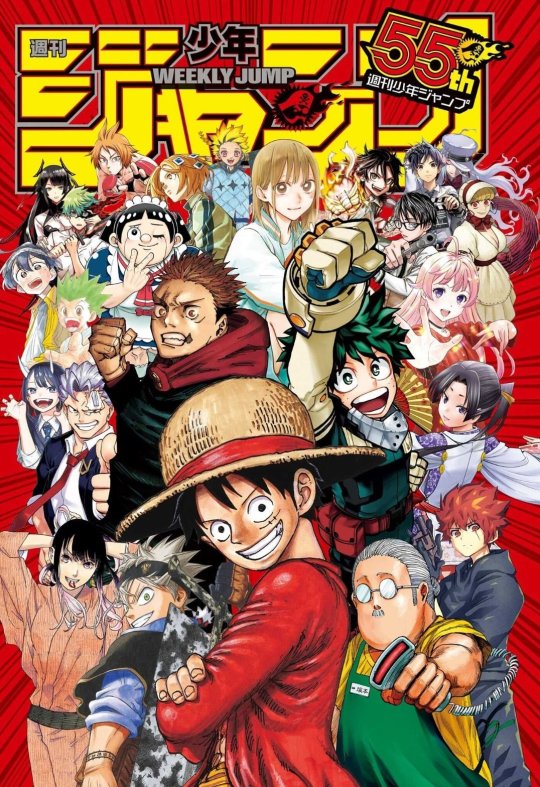
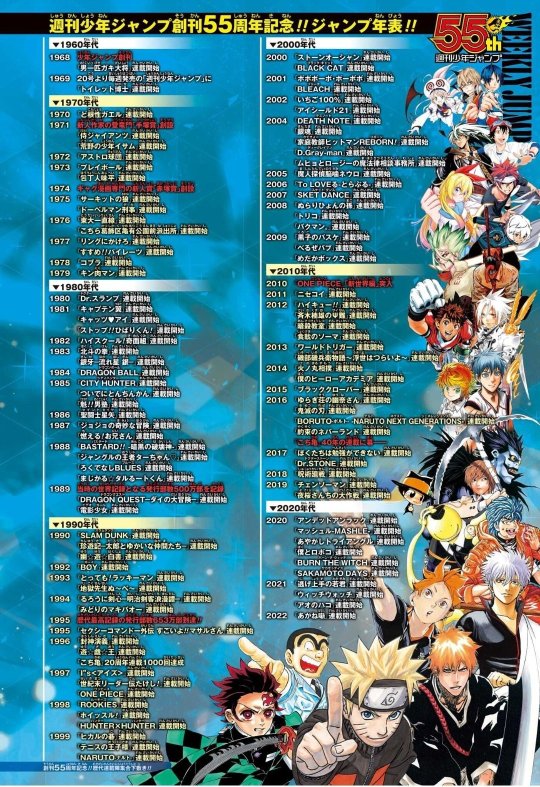
Weekly Shonen Jump 55th anniversary appendix in Weekly Shonen Jump 2023 issue #33
1968 Weekly Shonen Jump Issue #1 Otoko Ippiki Gaki-Daisho by Hiroshi Motomiya 1969 Dr. Toilet by Kazuyoshi Torii 1970 The Gutsy Frog by Yasumi Yoshizawa 1971 Tezuka Manga Award 1st Edition Samurai Giants by Ikki Kajiwara & Ko Inoue Boy of the Wilderness Isamu by Soji Yamakawa & Noboru Kawasaki 1972 Astro Kyudan by Shiro Tōzaki & Norihiro Nakajima 1973 Play Ball by Akio Chiba Hochonin Ajihei by Jiro Gyu & Jo Big 1974 Akatsuka Manga Award 1st Edition 1975 The Circuit Wolf by Satoshi Ikezawa Doberman Deka by Buronson & Shinji Hiramatsu 1976 Toudai Icchokusen by Yoshinori Kobayashi Kochikame by Osamu Akimoto 1977 Ring ni Kakero by Masami Kurumada Susume!! Pirates by Hisashi Eguchi 1978 Cobra by Buichi Terasawa 1979 Kinnikuman by Yudetamago 1980 Dr. Slump by Akira Toriyama 1981 Captain Tsubasa by Yoichi Takahashi Cat's Eye by Tsukasa Hojo Stop!! Hibari-kun! by Hisashi Eguchi 1982 High School! Kimengumi by Motoei Shinzawa 1983 Fist of the North Star by Buronson & Tetsuo Hara Ginga -Nagareboshi Gin- by Yoshihiro Takahashi 1984 DRAGON BALL by Akira Toriyama 1985 City Hunter by Tsukasa Hojo Miraculous Tonchinkan by Koichi Endo Sakigake!! Otokojuku by Akira Miyashita 1986 Saint Seiya by Masami Kurumada 1987 JoJo's Bizarre Adventure by Hirohiko Araki The Burning Wild Man by Tadashi Sato 1988 Bastard!! by Kazushi Hagiwara Jungle King Tar-chan by Masaya Tokuhiro Rokudenashi BLUES by Masanori Morita Magical Taluluto by Tatsuya Egawa 1989 Weekly Shonen Jump reaches 5.000.000 copies in circulation Dragon Quest: The Great Adventure of Dai by Riku Sanjo & Koji Inada Video Girl Ai by Masakazu Katsura 1990 SLAM DUNK by Takehiko Inoue Chinyuki by Man Gataro Yu Yu Hakusho by Yoshihiro Togashi 1992 Hareluya II Boy by Haruto Umezawa 1993 Tottemo! Luckyman by Hiroshi Gamo Hell Teacher Nube by Makura Sho & Takeshi Okano 1994 Midori no Makibao by Tsunomaru Rurouni Kenshin by Nobuhiro Watsuki 1995 Weekly Shonen Jump reaches 6.530.000 copies in circulation Sexy Commando Gaiden: Sugoi yo!! Masaru-san by Kyosuke Usuta 1996 Hoshin Engi by Ryu Fujisaki Yu-Gi-Oh! by Kazuki Takahashi Kochikame 20th Anniversary & Chapter 1000 1997 I's by Masakazu Katsura Seikimatsu Leader den Takeshi! by Mitsutoshi Shimabukuro ONE PIECE by Eiichiro Oda 1998 Rookies by Masanori Morita Whistle! by Daisuke Higuchi HUNTERXHUNTER by Yoshihiro Togashi 1999 Hikaru no Go by Yumi Hotta & Takeshi Obata The Prince of Tennis by Takeshi Konomi NARUTO by Masashi Kishimoto 2000 JoJo's Bizarre Adventure: Stone Ocean by Hirohiko Araki BLACK CAT by Kentaro Yabuki 2001 Bobobobo Bobobo by Yoshio Sawai BLEACH by Tite Kubo 2002 Strawberry 100% by Mizuki Kawashita Eyeshield 21 by Riichiro Inagaki & Yusuke Murata 2004 Death Note by Tsugumi Ohba & Takeshi Obata Gintama by Hideaki Sorachi Katekyo Hitman Reborn! by Akira Amano D.Gray-man by Katsura Hoshino Muhyo & Roji's Bureau of Supernatural Investigation by Yoshiyuki Nishi 2005 Neuro: Supernatural Detective by Yusei Matsui 2006 To Love Ru by Saki Hasemi & Kentaro Yabuki 2007 Sket Dance by Kenta Shinohara 2008 Nura: Rise of the Yokai Clan by Hiroshi Shiibashi Toriko by Mitsutoshi Shimabukuro Bakuman. by Tsugumi Ohba & Takeshi Obata 2009 Kuroko's Basketball by Tadatoshi Fujimaki Beelzebub by Ryuhei Tamura Medaka Box by Nisio Isin & Akira Akatsuki 2010 ONE PIECE New World Begins 2011 Nisekoi by Naoshi Komi 2012 Haikyu!! by Haruichi Furudate The Disastrous Life of Saiki K. by Shuichi Aso Assassination Classroom by Yusei Matsui Food Wars: Shokugeki no Soma by Yuto Tsukuda & Shun Saeki 2013 World Trigger by Daisuke Ashihara Isobe Isobee Monogatari by Ryo Nakama 2014 Hinomaru Zumo by Kawada My Hero Academia by Kohei Horikoshi 2015 Black Clover by Yuki Tabata 2016 Yuuna and the Haunted Hot Springs by Tadahiro Miura Kimetsu no Yaiba by Koyoharu Gotouge BORUTO by Mikio Ikemoto & Ukyo Kodachi The Promised Neverland by Kaiu Shirai & Posuka Demizu Kochikame 40th Anniversary and Serialization End 2017 We Never Learn by Taishi Tsutsui Dr. STONE by Riichiro Inagaki & Boichi 2018 Jujutsu Kaisen by Akutami Gege
2019 Chainsaw Man by Tatsuki Fujimoto Mission: Yozakura Family by Hitsuji Gondaira 2020 Undead Unluck by Yoshifumi Tozuka MASHLE by Hajime Komoto Ayakashi Triangle by Kentaro Yabuki Me & Roboco by Shuhei Miyazaki BURN THE WITCH by Tite Kubo SAKAMOTO DAYS by Yuto Suzuki 2021 The Elusive Samurai by Yusei Matsui WITCH WATCH by Kenta Shinohara Blue Box by Kouji Miura 2022 Akane Banashi by Yuki Suenaga & Takamasa Moue
#Weekly Shone Jump#One Piece#Dragon Ball#Naruto#Slam Dunk#KochiKame#Demon Slayer#Bleach#JoJo's Bizarre Adventure#Fist of the North Star#My Hero Academia#Hunter x Hunter#Jujutsu Kaisen#Yu Yu Hakusho#Kinnikuman#Rurouni Kenshin#The Prince of Tennis#Rokudenashi Blues#Gintama#Haikyu!!#manga#long post#late post
228 notes
·
View notes
Text
104th Hop Step Award - H☆S (October, 1993)
Togashi-sensei's Direct Instructions! The road to conquer all areas of manga!
Mass Recruitment for the 104th (October 1993 Term) H☆S Award!! This month's judge is Yoshihiro Togashi-sensei!

The Hop☆Step Award (H☆S Award) was a monthly recruitment project by Weekly Shonen Jump (Shueisha) that took place from March 1985 to July 1996.
I already translated Togashi's ten "4-koma" that he drew during the Yu Yu Hakusho serialization to give advice to the participants of the H☆S Award - October 1991 & 1992 Terms.
This time, I am translating the October 1993 Term, where he gives the newcomer manga artists more tips and advice on how to create different styes of manga. The winner of this edition was Eiichiro Oda with the one-shot "Ikki Yakō" (一鬼夜行). At the time, Yu Yu Hakusho was in the Black Chapter Arc.
Togashi gives instructions to help creating gag, love comedies, sports and fantasy manga. He used a little bit of all those elements in Yu Yu Hakusho.
Part 1. Gag Manga
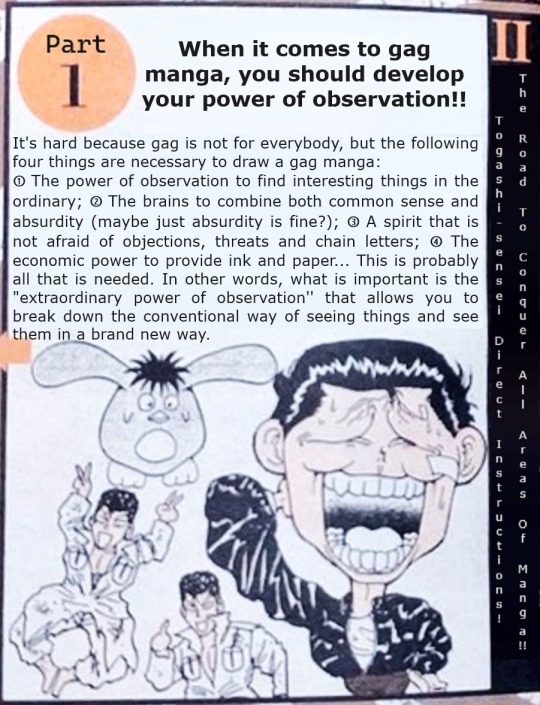
T/N: Chain letters (letters of misfortune) were popular in Japan during the Showa era. A ''letter'' or ''postcard'' was delivered to your home/work in the style of ''If you do not send it to a certain number of people, you will be unhappy.'' The sender is unknown. Chain letters were also a hot topic in magazines and manga, like Doraemon and a bunch of gag manga.

Source: Weekly Shounen Jump N°44, 1993. Shared by katsura_00
The funny versions of Yanagizawa, Kido and Kaito represent the editors in charge of:
Jungle King Tar-chan/DNA² (Kaoru Kushima);
Lucky Man/JoJo (KAITO Katsuhiko);
Yu Yu Hakusho/Monmonmon (Tomoyuki Shima)
Waiting for powerful works that will break these guys territories! !

They were responsible for the screening, checking all the applications and eliminating the mediocre works before passing them on to Togashi. Inside their territories, works with "characters that are all very similar," "characters with no strong personality at all" or "just imitations of existing characters" were mercifully discarded.
Part 2. Romantic Comedy


Source: Weekly Shounen Jump N°45, 1993. Shared by katsura_00
Part 3. Sports Manga

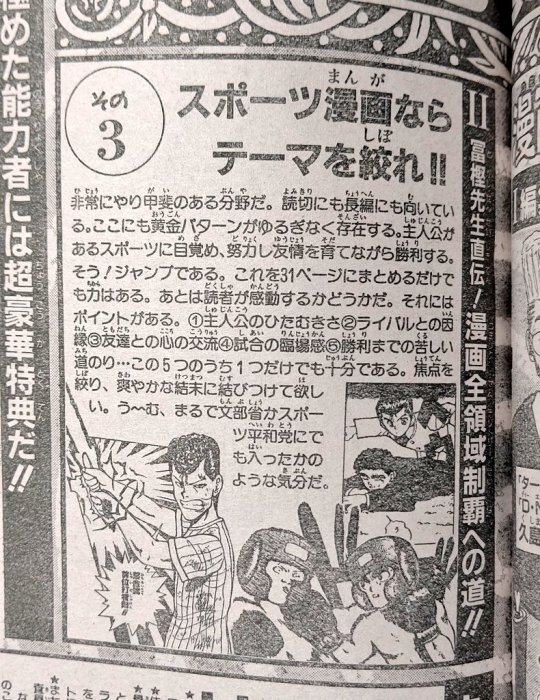
Source: Weekly Shounen Jump N°46, 1993. Shared by katsura_00
Part 4. Fantasy Manga
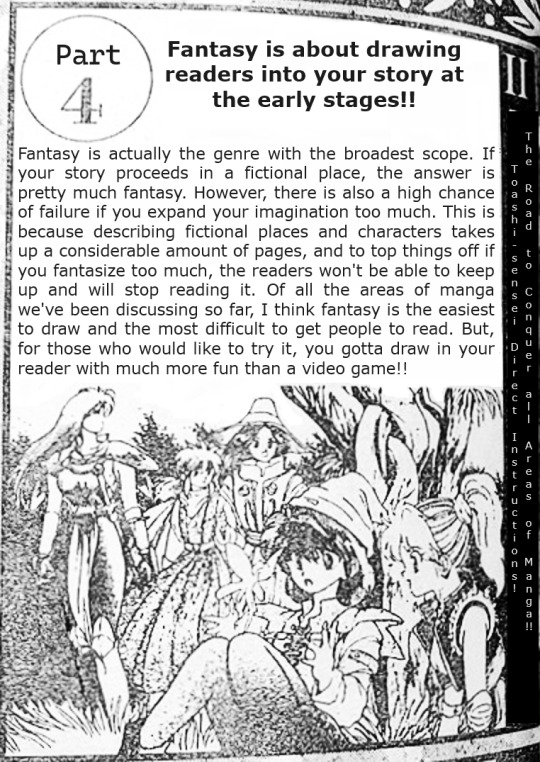
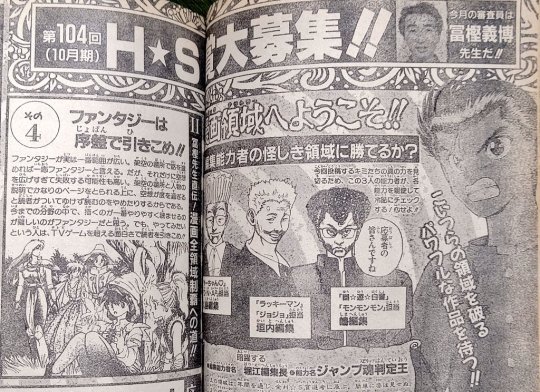
Source: Weekly Shounen Jump N°47, 1993. Shared by katsura_00
T/N: The fantasy illustration of Botan, Keiko, Yukina, Shizuru and Atsuko in medieval clothes was designed to the opening page of Yu Yu Hakusho volume 11, tankobon edition.
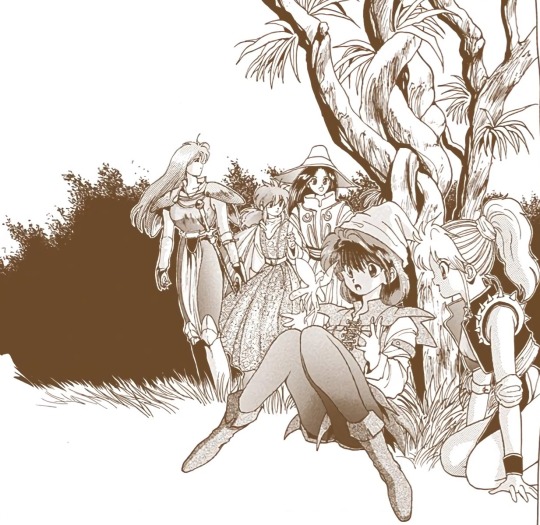
🏆 Winner: Eiichiro Oda
Oda-sensei was the inner of this edition! Togashi-sensei reviews his 31-page one-shot, "Ikki Yakou", that was published in the 1994 Shonen Jump Spring Special, and later reprinted in 1998 as part of Wanted!, a compilation of Oda's pre-One Piece stories.
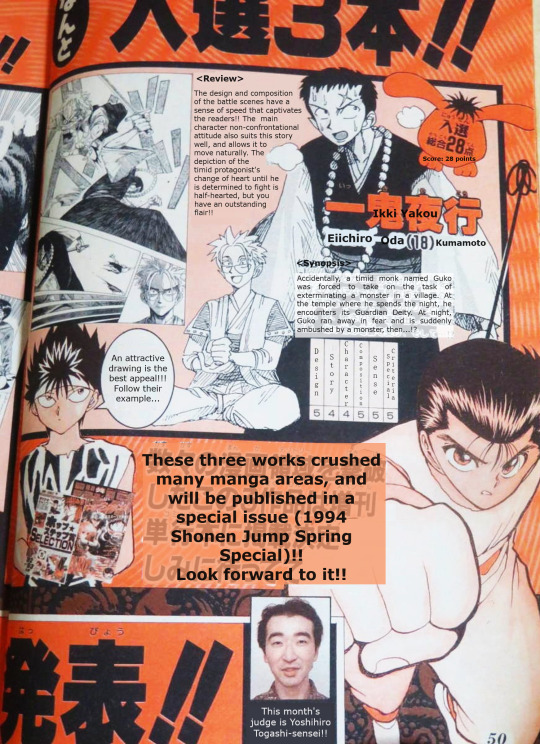
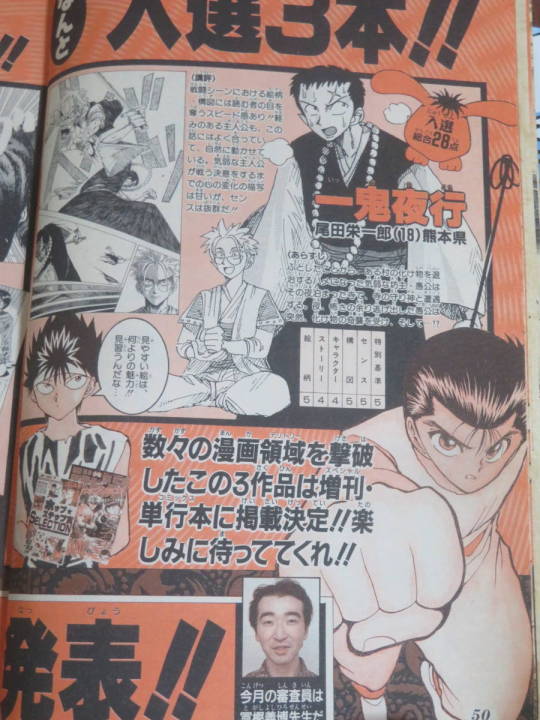
Source: Weekly Shounen Jump N°2, 1994
#Yoshihiro Togashi#Yu Yu Hakusho#hop step award#Weekly Shounen Jump#1993#H☆S Award#gag manga#romantic comedy#Eiichiro Oda#sports manga#Togashi's advice#一鬼夜行#Night Parade of One Demon#fantasy manga
31 notes
·
View notes
Text
Shredding Psychohistory
So, thanks to @hood-ex, I had to write this, because there is much of Lloyd de Mause's work which is, simply not factually true. (No relation to the fictional field of Asimov's Foundation series, though they share some similarities.)
So, where to begin? Perhaps the dearth of actual academic departments of psychohistory. (There are none. Partially because they can't decide if it belongs in Psychology or in History, and partially because de Mause is a Freudian at the end of the day. More on that in a bit.)
So, Freud, psychoanalysts are very reverent toward their founder. Freud believed in recapitulation theory (long-discredited among developmental biologists), so psychoanalysts must believe in recapitulation theory. (In particular, Freud viewed the Oedipal/Electra as recapitulating a patricidal past.) De Mause similarly sees postpartum depression as proof of an infanticidal past, and babysitters as proof of a past of outsourcing care of one's children, including pederasty.
Beyond this, Freud is solid gold to psychoanalysts, except, apparently, that part where Freud viewed homosexuality as harmless and incurable; many psychoanalysts offered quack cures to homosexuality. To his credit, and I will credit him when he is right, broken clocks and all, I haven't seen any evidence of de Mause offering such. De Mause himself says Leonardo da Vinci had visions of vultures; this is Freud's conflation of two parts of da Vinci's notes, one being a vision of a swallow and another part about vultures. (But in Freud's work, all birds are phallic symbols; there are so many Indo-European "avian" names for the penis, after all. In English, we have "cock" and "robin". Spanish has "polla". And so on in that manner.)
The simplest problem with de Mause was his hostility to peer review, regarding anyone who disagreed with him in the slightest, even on factual matters such as if children were being sacrificed to Satan in a hidden basement in a daycare center (Hey, sound familiar, anyone? Sound like Pizzagate?) and the children themselves said they were sacrificed. (Yeah, literally, the children told stories of being ritually murdered, but they're better because Jesus showed up and fixed everything. By the way, no one saw the absurdity of this until 1989, over a decade after the first claims of Satanic ritual abuse.)
The absurdities didn't end there. Per de Mause, Japanese women publicly masturbate their sons (gleaned from pages of Jungle King Tar-chan and its phallic humor), but it's a huge secret. (Apparently those two things being incompatible never came to mind.) World War I wasn't caused by imperial rivalries, nor was Nazi Germany (which de Mause conflates with World War I) caused by the culture of antisemitism in Europe; instead, it was all because of German and Austrian parenting practices.
This is actually not new for psychoanalysts. Erikson drew on secondhand reports about Luther's life in his biography of Martin Luther. And we already covered Freud, da Vinci, and vultures.
So, what do we have? People who trust the words of deviants, the words of very alive self-styled murder victims, plenty of quote mining, second-hand sources (at best), and outright fabrication. We have very discredited theories, urban legend, and conspiracy theories. I have to give psychohistory an F, but I could see how it was popular in the cult-obsessed 70s.
1 note
·
View note
Text
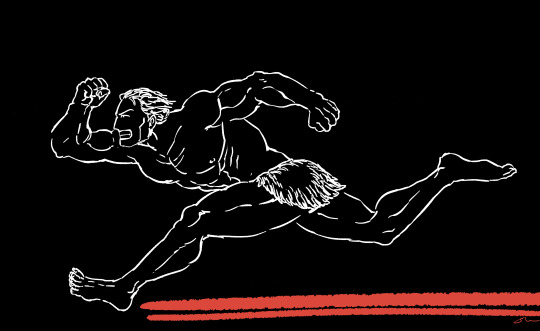
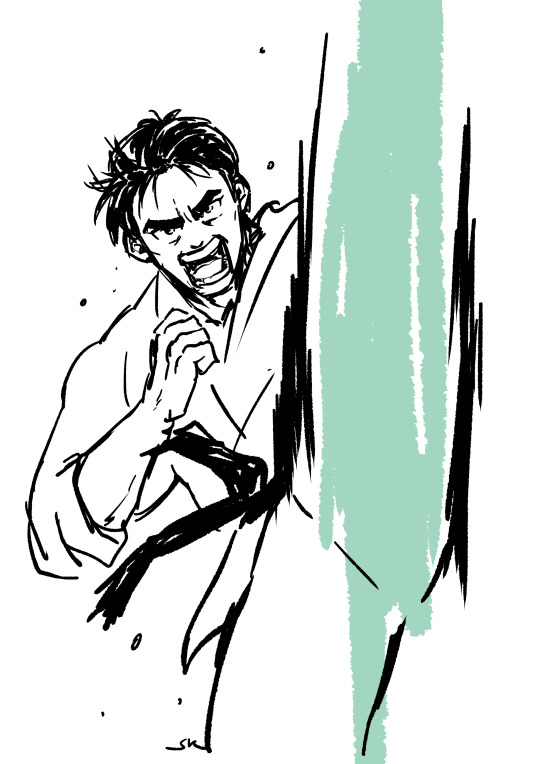
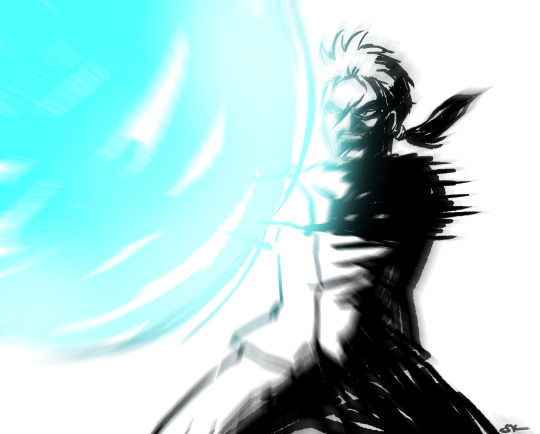
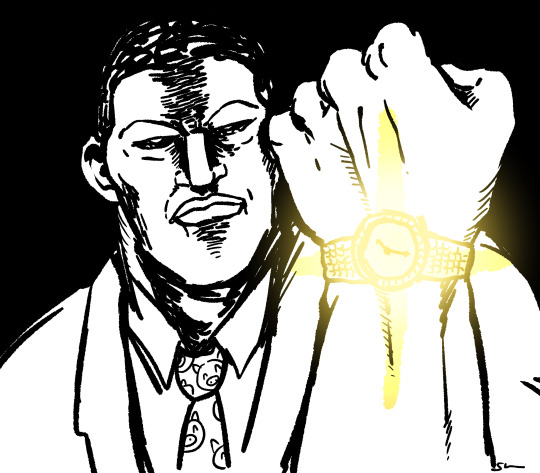
Jungle King, Jungle no Ouja Tar-chan
0 notes
Text

11 notes
·
View notes
Text




Jungle King Tar-chan
45 notes
·
View notes
Photo

Today in Manga History
March 21st, 1988
Jungle King Tar-chan begins serialization in Weekly Shonen Jump
Written and illustrated by Masaya Tokuhiro
8 notes
·
View notes
Text


Jungle king Tar-chan(ジャングルの王者ターちゃん)
I think, this comics will only be known by Japanese.
4 notes
·
View notes
Photo










Jungle King Tar-chan // ジャングルの王者ターちゃん — vol. 1-10 — by Masaya Tokuhiro
34 notes
·
View notes
Video
youtube
#Shueisha#Shonen Jump#Mazinger Z#Space Cobra#Kinnikuman#Cat's Eye#Captain Tsubasa#Yoroshiku Mechadoc#Fist of the North Star#Dragon Ball#Ginga: Nagareboshi Gin#Saint Seiya#City Hunter#Sakigake!! Otokojuku#DBZ#YuYu Hakusho#Slam Dunk#Jungle King Tar-chan#Ninku#Rurouni Kenshin#Midori no Makibao#Hell Teacher Nube#Sexy Commando Gaiden: Sugoi yo!! Masaru-san#Yu-Gi-Oh!#Hoshin Engi#Hunter X Hunter#One Piece#retro#vintage#8-bit
4 notes
·
View notes
Photo

Jungle King Tar-chan
Genre : comedy, adventure, shonen, parody
Аnime series : 50 duration 25 min
#Jungle King Tar-chan#Jungle no Ouja Tar-chan#anime#retro anime#anime series#anime 90s#anime adventure#anime comedy#anime parody#shonen
6 notes
·
View notes
Note
Hi! First things first, love your blog! Now I have a question to ask - I noticed that from your gifs of JUNGLE NO OUJA TAR-CHAN on Gameboy, it looks like a side scrolling platforms, but when I look up the game anywhere else, it looks like an overhead Legend of Zelda type game. I’m just curious to know, because the side scrolling game looks kinda fun!
Believe it or not, it’s both! Sort of like Zelda 2, the game has a top-down overworld and then switches to side-scrolling for the action areas and boss fights.





62 notes
·
View notes
Text
The saga continues..



Everybody feast your eyes on..
HANDSOME VINTAGE JOOT 😫😱🔥


#jotaro looking like an absolute twink here#ALSO PURPLE SCARF PLATINUM#WITH BLACK SHOULDER PADS 😒#green!taro on the other hand 👌#jojos bizarre adventure#jotaro kujo#shounen jump#stardust crusaders#hirohiko araki#ikemen joot#jjba part three#anime memes#Famicom Jump II: Saikyō no Shichinin#bandai#Ta-chan (Jungle King Tar-chan)Tarurūto (Magical Taluluto)Maeda Taison (Rokudenashi Blues)#Son Goku (Dragon Ball Z)Ryotsu Kankichi (Kochira Katsushika-ku Kameari Kōen-mae Hashutsujo)Momotaro Tsurugi (Sakigake!! Otokojuku)
173 notes
·
View notes
Text
Animation Night 61: One Piece
So first up... ty everyone who tuned in for Heaven’s Feel last week! That was a blast: the fights were everything I hoped for and the whole chuuni traumagirl story arc was genuinely moving and compelling. Can’t really recommend it as a first Fate necessarily, since it skims over the early parts of the story portrayed already in Unlimited Blade Works, but I reckon those movies deserve all their esteem.
(Also, apologies for lack of Toku Tuesday this week. Plans fell apart and I wasn’t up to running one. We’ll be back next week.)

This week on Animation Night, I’m going to take up a long standing request from my friend Elaine [scattermoon], who is a big fan of a certain very long running manga series called One Piece. (I realise that among my friends that is a rather divisive choice! But hey, let’s give it a shot.)
One Piece began serialisation in Weekly Shōnen Jump in 1997, the creation of a young assistant mangaka called Eiichiro Oda. About the young Oda I can mostly find production info: he joined the company in 1992 on the strength of his manga Wanted!, then developed his drawing skills working under mangakas like Shinobu Kaitani on Suizan Police Gang and Masaya Tokuhiro on Jungle King Tar-chan and Mizu no Tomodachi Kappaman. In 1996 he wrote two piratical one-shot stories called Romance Dawn, the prototype for One Piece; then after three rejections, Jump agreed to run his series One Piece.
And One Piece got big. I don’t know exactly when it became a hit, but it soon became recognised as one of Jump’s “Big Three” series alongside Naruto and Bleach... and then outgrew even them to set the record for best-selling manga, overtaking even industry-defining series like Dragon Ball. Unusually for mangaka, Oda became extremely rich - yet he has continued to work singlemindedly on One Piece, taking almost no breaks outside of a number of health scares.

So what’s the formula that made it so beloved to its many many, fans?
Overall the structure for One Piece is a travel story. The broad-scale framing plot is that our MC, Monkey D. Luffy, and the “Straw Hat Pirates” (麦わらの一味, Mugiwara no Ichimi) who sail with him, are hoping to find a treasure called the “One Piece”, which would make Luffy the “King of the Pirates”. Along the way, they get caught up in the conflicts of a long series of islands, each one relatively self-contained as an arc. In the meantime, the metaplot concerns an unfolding pirate war between the four most powerful pirates (the Four Emperors 四皇 yonkō), opposed to the authority of the World Government.
So if at first glance it may sound like standard shōnen stuff - individuals with different superpowers, contesting to become the strongest. But it’s clearly finding much broader appeal than that. I asked Elaine a bit about this, and she reckoned its main strength is the variety: like many successful, long-running TV series (for example, Star Trek), the premise is so flexible that it allows Oda to explore an enormous variety of affects and registers, all anchored in familiarity with the core cast. Some examples are an underwater arc exploring xenophobia and generational prejudice among fish people, a thriller arc where the characters flee poison clouds in a sinister human experimentation lab, and a political intrigue arc about a rich man attempting to stage a coup in a desert kingdom.
Beyond that, it distinguishes itself mostly in execution: a big part of the appeal is the implication of a vast, fleshed-out world painted across thousands of issues. This is built on a distinctive visual foundation: Oda can design a wildly varied cast and give them all distinctive characterisation. (Even if he is, apparently not nearly so good at designing women... 🙄)
One other small tidbit Elaine gave me was that, contra the shōnen designation and Jump’s usual audience, by far the biggest demographic of One Piece readers is women aged 30-40.
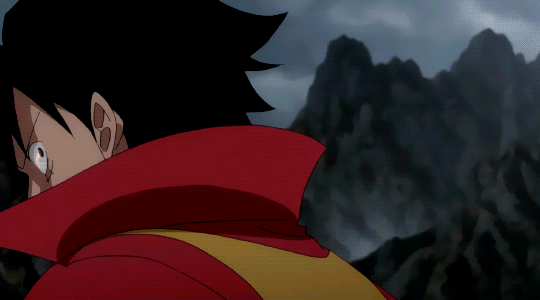
Inevitably a series as big as One Piece would see a high-profile anime adaptation, and that landed in the hands of the venerable Toei Animation, one of the oldest anime companies. They picked up the series in 1999, and it has run in a variety of timeslots - shifting from Wednesday to the prime Saturday Evening slot before narrowly avoiding cancellation to settle in the Sunday Morning slot with other long-running shows like Dragon Ball Super. This is relevant insofar as, well...
Let’s talk a little about anime production! A subject I know a lot more about than the plot of One Piece...
Most anime nowadays are produced according to a model called the Production Committee, originating in high-profile films like Akira. In this system, various capital blocs - toy companies, music companies, broadcasters etc. - pool funds in return for a comparable stake in the profit or loss made by the series, mitigating risks but also reducing the potential for profit. The studio producing the actual animation (the primary contractor) may have a stake in the committee, but often they are only paid a single, fixed fee.
The production committee system has come under a lot of fire lately as one of the barriers in the way of livable wages for animators (e.g. this rather disjointed video by the Animator Dormitory charity): a successful series may not profit the animators at all since the fixed fee is very low and, if the studio’s not on the production committee, they don’t even have the opportunity to give the animators residuals (like in Hollywood) and often face severe budget shortfalls despite often paying sub-poverty piece rates.
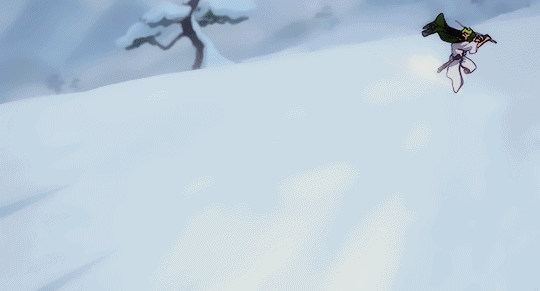
Per this video, One Piece is run on a somewhat older sponsorship model with three sponsors making joint decisions: Toei themselves, the manga publisher Shueisha, and the broadcasting network Fuji TV. (I’m not exactly sure how this differs from the more standard production committee, but I guess I just gotta take the guy’s word for it...)
In some ways this is good: One Piece is pretty much guaranteed a large audience share just because of the license so the risk is minimal, and thanks to such productions, Toei is able to pay its animators some of the best monthly salaries in the industry. (The fact that they do is thanks to the union which struggled into existence in the early days of the studio, back when it was Toei Dōga.) But this arrangement comes with some restrictions: the Saturday morning timeslot comes with a very high pace of production of 48 episodes per year, drawing a lot of complaints of extremely slow pacing. Toei are not free to ‘go seasonal’ to spend more time per episode, because the other sponsors are making a tidy profit and see no reason to change for artistic reasons.
The exact history of the anime seems to have gone through a few eras. As Elaine described it, the first 80 episodes (1999-2001) adapt the first major arc of the manga at a reasonal pace; from that point until about 2008, the series interspersed ‘filler’ arcs between manga adaptations. From that point, they adopted a slower-paced model where, rather than write filler, they would adopt only one chapter of the manga per episode. Fans were not especially happy at the slow pace, or a widely perceived drop in animation quality.

These criticisms were apparently answered with a change in direction for the most recent “Wano” arc, which is where One Piece clips started appearing on the radar of sakuga fans - such as this cut by Katsumi Ishizuka which currently stands as the top rated from One Piece on the booru, or this one by webgen star Bahi JD. These have all the hallmarks of modern fight sakuga: heavy Yutapon influence, lots of flashy impact frames, lines dissolving, the camera and characters flying about. You can check out more of this Wano thing here on the booru. (I get the impression something quite similar has happened to the Naruto sequels.)
Meanwhile, on the manga side, Oda has apparently been attempting to condense more events into each chapter of the manga to better suit the pace of the adaptation - alluding to a fight which the animators can then elaborate on. So perhaps the pacing troubles are coming to an end... the manga, in any case, remains astoundingly popular, untouchable by anything in Jump.
Anyway! That is, as best as I understand it, the history of the One Piece TV show. However... we’re not watching that tonight. Instead, Elaine has picked out a handful of One Piece films...

Much like the TV series, the One Piece films have gone through various eras. The earliest films tended to be purely original stories, often diverging significantly from the source material; a second era saw higher-budget, condensed retellings of arcs already covered by the TV series; the third, current era of films consists of side stories overseen (and one time written) by Oda, but not directly part of the main story. Elaine’s given me one film rec from each era to give us a little historical core of the series
From the first era, we have Baron Omatsuri and the Secret Island (2005), which is notably the second film directed by Mamoru Hosoda [previously on Animation Night #15 and #47] after Digimon: The Movie. We can already see some elements of his style, like the kagenashii (unshaded) animation. The film sees the Straw Hat Pirates drawn into a series of trials on an unfamiliar resort island, but inevitably more sinister things are afoot - hinging on a flower that resurrects facsimiles of the dead.
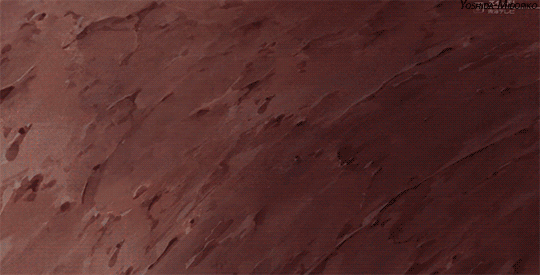
The second era brings us the Fate-worthy title Episode of Chopper Plus: Bloom in the Winter, Miracle Sakura (2008), a retelling of the ‘Drum’ arc focusing on the character Tony Tony Chopper who is a kind of anthro reindeer?? The Straw Hats show up on a winter island, seeking medical treatment, and seem to get drawn into some kind of furry banditry situation where they’re attacked by big rabbits. It sounds wild and I’m very curious to see how that all comes together.
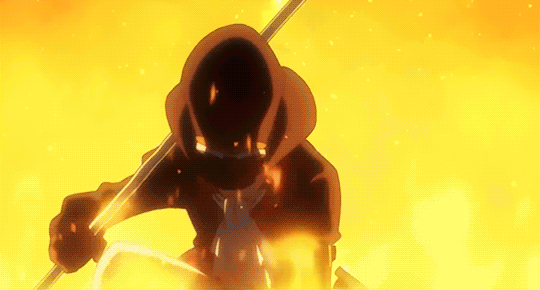
Last, we have One Piece Film: Gold (2016), from the current side-story-oriented era. In this one, the Straw hats find themselves on a kind of giant casino ship, where a conflict over cheating at dice draws them into a battle for control over the whole ship.
So. One Piece! I’ve never really dipped my toe in, just aware it’s a thing people love - but I’m absolutely curious to peer into this whole enormous psychic whirlpool that has been churning at the centre of the manga/anime industry for most of my lifetime. Fingers crossed we’ll find something delightful in here that appeals even to the One Piece skeptic. And time permitting, I’ll also throw in an episode from that Wano arc for the sakubutas among us to roll around in.
Animation Night 61 is intended to start at about 7PM UK time, 1h40m from this post, over at twitch.tv/canmom. In the meantime, I’m going to be challenging myself to animate a flashy punch in about an hour, so drop by Twitch if that sounds fun! See you there, either way~
8 notes
·
View notes